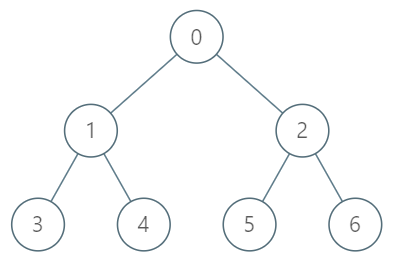1483.Kth Ancestor of a Tree Node¶
Tags: Hard Dynamic Programming
Links: https://leetcode.com/problems/kth-ancestor-of-a-tree-node/
You are given a tree with n nodes numbered from 0 to n-1 in the form of a parent array where parent[i] is the parent of node i. The root of the tree is node 0.
Implement the function getKthAncestor (int node, int k) to return the k-th ancestor of the given node. If there is no such ancestor, return -1.
The k-th ancestor of a tree node is the k-th node in the path from that node to the root.
Example:

Input:
["TreeAncestor","getKthAncestor","getKthAncestor","getKthAncestor"]
[[7,[-1,0,0,1,1,2,2]],[3,1],[5,2],[6,3]]
Output:
[null,1,0,-1]
Explanation:
TreeAncestor treeAncestor = new TreeAncestor(7, [-1, 0, 0, 1, 1, 2, 2]);
treeAncestor.getKthAncestor(3, 1); // returns 1 which is the parent of 3
treeAncestor.getKthAncestor(5, 2); // returns 0 which is the grandparent of 5
treeAncestor.getKthAncestor(6, 3); // returns -1 because there is no such ancestor
Constraints:
1 <= k <= n <= 5*10^4parent[0] == -1indicating that0is the root node.0 <= parent[i] < nfor all0 < i < n0 <= node < n- There will be at most
5*10^4queries.
class TreeAncestor {
vector<vector<int>> ancestor;
public:
TreeAncestor(int n, vector<int>& parent) {
std::ios_base::sync_with_stdio(false);
cin.tie(NULL);
cout.tie(NULL);
ancestor.resize(50005, vector<int>(21));
for (int i = 0; i < n; ++i) ancestor[i][0] = parent[i];
for (int j = 1; j <= 20; ++j) {
for (int i = 0; i < n; ++i) {
ancestor[i][j] = (ancestor[i][j - 1] >= 0) ? ancestor[ancestor[i][j - 1]][j - 1] : -1;
}
}
}
int getKthAncestor(int node, int k) {
for (int i = 0; i <= 20; ++i) {
if (k & (1 << i)) node = ancestor[node][i];
if (node == -1) return -1;
}
return node;
}
};
/**
* Your TreeAncestor object will be instantiated and called as such:
* TreeAncestor* obj = new TreeAncestor(n, parent);
* int param_1 = obj->getKthAncestor(node,k);
*/
倍增和二进制的思路。类似于ST表,我们用ancestor[i][j]表示节点i的第2^j个祖先,很显然当j = 0时,ancestor[i][0]就是parent[i]。
当j >= 1时,ancestor的状态转移方程:
ancestor[i][j] = (ancestor[i][j - 1] >= 0) ? ancestor[ancestor[i][j - 1]][j - 1] : -1;
也就是节点i的 2^j个祖先, 就是节点i的第2^{j-1}个祖先节点的第2^{j-1}个祖先。
因为数据范围节点数不会超过50000,所以第一个维度开50005的大小,第二个维度是21是因为数据范围到了10^6,一般用ST表求RMQ顶多到10^6的数据范围,\log _2 10^6 \approx 19.93,开21或25的大小都可以。
考虑getKthAncestor,比如我们想查询节点i的第13个祖先,离13最接近的是8,然后将5拆成4和1,这其实就是13的二进制表示,也就是如果想访问第13个祖先,那么先利用ancestor查找第8个祖先,将第8个祖先作为当前节点,然后查找当前节点的第4个祖先,依此类推。
最坏的情况是单链表的情形,树的深度最大是5 \times 10^4,查询次数是5\times 10^4,时间复杂度O(n \log n)。